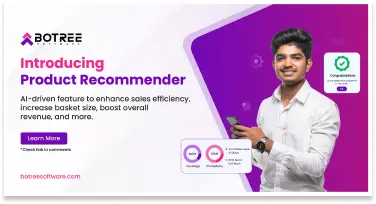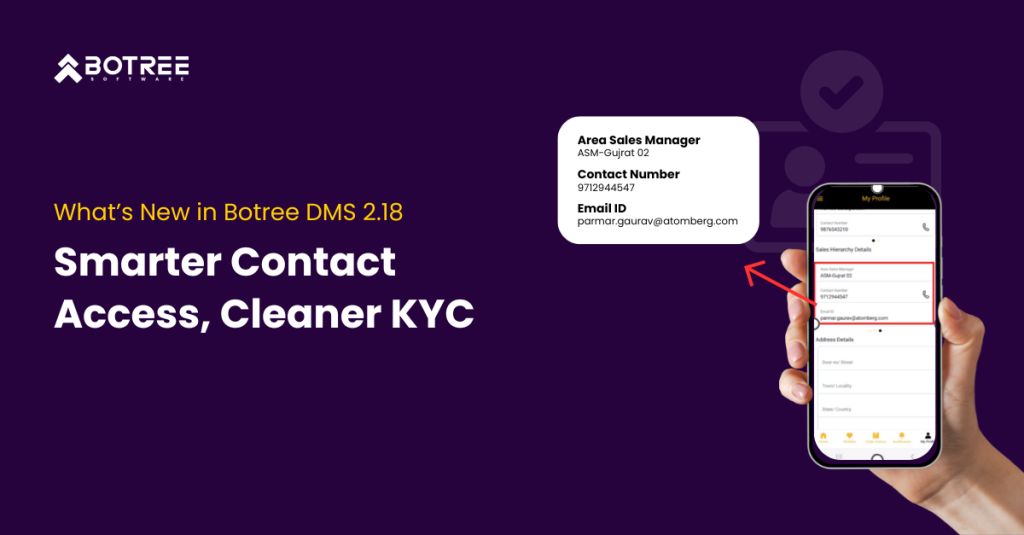
Achieving Visual Merchandising Excellence with Botree Software
Achieving Visual Merchandising Excellence with Botree Software Share: Share on

Achieving Visual Merchandising Excellence with Botree Software Share: Share on

Introducing the AI-Driven Product Recommender to Maximize Basket Size at Every Outlet
We are thrilled to introduce our latest innovation, the Product Recommender, designed to transform the way businesses optimize their product offerings and enhance sales productivity.

Imagine yourself as a retailer trying to contact your salesperson, but their name is missing from your app, or you might be a distributor who recently had a transfer between distributors done without your approval. Alternatively, you could be facing problems because the names on your PAN and Aadhaar don’t exactly match. These are not just system errors; they are real, everyday frustrations.
This update addresses those specific problems. We focused on improving the core functions to work more intelligently, transparently, and quickly. We have fixed the issues you reported and added just the right amount of intelligence to keep things running smoothly.
Here’s a brief overview of what’s included:
Let’s look at the latest updates and explore the benefits they offer for your company.
Let’s take a common situation. A retailer places an order but doesn’t get the delivery on time. They try calling their usual salesperson to find out, but that person is no longer available. There are no updates, no one answers the call, and the only option left is to escalate the issue—but to whom? With no visibility in the Retailer App, it turns into a frustrating waiting game filled with guesswork.
When they don’t know whom to reach out to, it impacts more than just one order. It damages trust, creates operational delays, and can lead to lost sales opportunities.
The Solution: To address this, we took a step back and reconsidered how visibility should function in the app. The solution is simple yet impactful: incorporate the entire sales hierarchy from DMS directly into the ‘My Profile’ section of the Retailer App. Now the appropriate contact is only a tap away
A retailer’s weekly shipment was missing, and the regular sales representative was unresponsive to calls. Following a series of frustrating exchanges, they again checked the updated Retailer App. In the ‘My Profile’ area, they located the contact information for the newly appointed ASM. After one call, the problem was fixed, and the delivery was rescheduled. What might have led to delays and missed sales was swiftly addressed. “I didn’t need to pursue anyone—I simply looked at the app and resolved it.”
A distributor checks their stock report only to discover that items have been relocated—without their awareness. They start to wonder who started the transfer, the reasons behind it, and if it was truly needed. This occurred way too frequently.
Inter-distributor transfers (IDTs), though essential, were conducted without any supervision. Anyone with the appropriate access could trigger a transfer, and it would start to process immediately. There were no inspections, no alerts, and no authorizations. While it might have saved time in certain instances, it resulted in miscommunication, poor inventory management, and possible compliance problems.
The Solution: We introduced a formal approval matrix into the IDT process. Now, every transfer request goes through a clearly defined workflow. Depending on how it’s configured, the request might need to pass through one or more levels of approval before anything is moved. Notifications and real-time tracking give both initiators and approvers full visibility.
A distributor observed unaccounted stock inconsistencies in the system—transfers occurred without his awareness. Following the update, he got a transfer request straight in DMS. The particulars were evident, and after a single review, he authorized the transfer. From that point on, each transfer is confirmed, authorized, and recorded. “I understand what’s happening, when it occurs, and the reasons behind it—no more unexpected events.”
Picture accessing the system and seeing a notification: “KYC Unsuccessful.” “Kindly update your information.” You verify your Aadhaar and PAN again, and all appears to be in order. However, the system disagrees. You’re unable to log in, can’t receive immediate assistance, and you’re uncertain about the issue.
This was the situation for many users. Minor differences—an additional character, a name capitalized entirely, a missing middle name—might cause a mismatch between legal and trade names. Without an automated method for verification and retries, users found themselves in a state of uncertainty.
The Solution: We developed a smarter KYC procedure. A system that not only prevents you from proceeding on mismatches but also clarifies the reasons, offers an opportunity to correct the issue, and highlights only significant mismatches requiring manual approval.
Mandatory Verification Now Applies To:
GST Verification Flow:
PAN & Aadhaar Verification:
Fuzzy Name Match Scoring:
Scoring logic:
Approval is triggered based on scores generated for both legal and trade names.
Approval Flow (If Score < 100%):
During the process of updating PAN information in the system, a retailer mistakenly input a name that was slightly misspelled. The system promptly identified the discrepancy, leading to a swift adjustment on the second try. No assistance calls, no hold-ups. “It identified the mistake prior to submission—I corrected it in moments and proceeded.” What might have developed into a lengthy problem was addressed immediately, due to the integrated verification.
Submitting GST returns is already complex. Picture generating a report that combines B2B and B2C sales on a single sheet, offering no means to differentiate between the two. That was the previous GSTR-1 report. Users were required to manually extract, clean, and reorganize data—an exasperating task that consumed hours.
The absence of clarity wasn’t merely a frustration. It posed a genuine danger. Errors in tax submissions, inaccurate reporting, or late filings were frequently encountered.
The Solution: We reworked the GSTR-1 report to provide distinct, clear perspectives on B2B and B2C HSN information. Users can now easily determine which transactions fit into each category—including returns and type of customer.
The HSN summary is now split into two separate sheets:
A tax advisor overseeing KYC for various clients would spend hours organizing and formatting Excel spreadsheets. The latest update enables the system to produce two polished, upload-ready reports immediately. “It’s a lifesaver.” What used to require hours of manual work is now completed in minutes—precise, effortless, and prepared for use.
A distributor provides the identical product to the same client each week. However, every time they invoice, they must recall the price that was previously utilized. Occasionally they estimate, occasionally they look over a previous invoice. In either case, it requires a lot of time and is susceptible to mistakes. Variable pricing results in disagreements, uncomfortable conversations, and audit complications.
The Solution: We incorporated historical price data into the billing interface. Starting from the second invoice, the system automatically informs the previously used price for that specific product-customer pair. It remains editable, but at least the price is visible.
A shopkeeper who previously depended on a physical notebook to record previous prices now observes that the accurate amount is automatically filled in during checkout. “It’s similar to automatic billing.” What was once a manual, error-laden process is now instantaneous and smooth—resulting in quicker and more precise transactions.
Each of these updates may seem small on their own—but they’re all rooted in the same idea: solving real problems that disrupt real work.
Whether it’s a retailer unsure who to contact, a distributor blindsided by stock transfers, or a user stuck in KYC limbo, these aren’t abstract issues. They’re daily roadblocks that chip away at trust, efficiency, and time. With this release, we’ve worked to remove those blockers—not just by fixing bugs, but by rethinking how the system should behave in the first place.
From smarter visibility and approvals to better compliance and data consistency, these changes are designed to make the everyday smoother, faster, and more reliable for everyone involved.
We’re not just adding features—we’re removing friction. And we’re just getting started.
Meet Christina Evangelin Ebinezer, our dynamic marketing associate at Botree Software. With a background in HR and marketing, and prior experience as a content writer, Christina brings a sharp eye for storytelling and a knack for crafting engaging blogs and marketing content. She’s passionate about turning ideas into words that drive impact. Outside of work, Christina finds joy behind the piano keys or the wheel—whether she’s playing a soulful tune or cruising down open roads.
